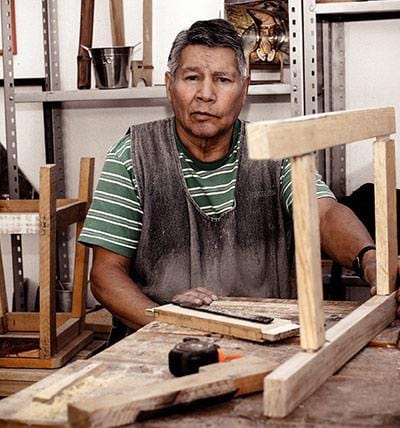It's way back in the day, and the Chinese are faced with a conundrum - how do they tackle their mealtime mischief? These nifty little sticks, made from humble bamboo, steal the spotlight with their simplicity and versatility. Forget fancy silver chopsticks or a knife and fork combo; the Chinese got themselves some good ol' chopsticks. Now, let me tell ya, there's a tale that says it was none other than Confucius himself who popularized the use of chopsticks in China.
But hey, take it with a grain of salt, 'cause we're talkin' ancient history here. Anyway, back to those chopsticks. Made from bamboo, these bad boys were cheap, abundant, and oh-so-practical. No need to turn 'em black like silver, no fancy jade or agate decorations. Nope, just a simple twig-like tool, perfect for getting the job done. And let's not forget; the Chinese were wise souls - they didn't want any fork to go jabbin' through their food like a wild animal in a slaughterhouse. Oh no, chopsticks provided a gentler touch, a more refined way to savor their culinary delights. Plus, they were all about sustainability, ya know? No ivory or fancy materials are needed, just a good ol' piece of bamboo.
The Origin of the Chopstick: A Key Aspect of Chinese History
Let's take a trip down memory lane and uncover the fascinating origin of chopsticks, a true cornerstone of Chinese history. These slender sticks, known as chopsticks, are commonly used to eat in Chinese restaurants and have become synonymous with Asian cuisine. Now, way back in the day, during the Shang Dynasty, the earliest chopsticks were invented. Back then, these chopsticks were made mainly of bronze and were primarily used for cooking.

But hey, the ancient Chinese were a clever bunch, and they soon realized that these chopsticks could also be handy for eating. Wooden chopsticks became popular, allowing people to savor their rice and other delectable dishes.
And get this, my friends, chopsticks are still widely used today, not just in China but in many Asian countries. Even in Japan, they've got their version of chopsticks! Now, let's talk about function. You see, chopsticks aren't just about eating; they play a role in religious ceremonies too.
Back in the day, when the risk of poisoned food or rotten eggs was high, people believed that using chopsticks could help them avoid any nasty surprises. Plus, unlike an uneven pair of utensils, chopsticks were handy for picking up morsels and even allowed the soup to drip back into the bowl. Talk about resourceful! So, whether you're at a funeral or feasting in Henan Province, chopsticks come to the rescue. And, if you were feeling fancy, diners could even eat with ivory chopsticks.
Smart move, sticking to bamboo or wood, right? It's amazing how something as simple as chopsticks has stood the test of time and become the eating utensils of choice for so many. From conserving fuel by cutting down cooking time to keeping knives away from both the slaughterhouse and the kitchen, chopsticks have woven themselves into the fabric of Chinese culture. So, next time you're using chopsticks to enjoy a mouthwatering dish, take a moment to appreciate the rich history and ingenuity behind these remarkable utensils.
Chinese Chopsticks: An Evolution in Function and Use Over Time
These humble utensils have evolved in function and use over time, adapting to the needs and tastes of the Chinese people. Back in the early days, chopsticks were primarily used for cooking, my friends. Picture this: ancient Chinese cooks skillfully wielding bronze chopsticks, stirring up a storm in their pots and pans. As time went on, these trusty sticks transitioned from the kitchen to the dining table. People began using chopsticks to eat, realizing their practicality and versatility. Chopsticks became more than just eating tools; they were used in religious ceremonies and became symbols of tradition and respect. Over the years, chopsticks have been made from various materials, from bronze to wood and even ivory for fancy feasters. And, did you know that around the 12th century, chopsticks even had some competition?
That's right, the fork and spoon made their appearance, but chopsticks held their ground. They were the go-to utensils for grabbing bites of rice, noodles, and other scrumptious treats. Now, fast-forward to today, and chopsticks are produced in abundance, catering to chopstick enthusiasts worldwide. From elegant wooden chopsticks to the convenience of disposable chopsticks, there's a pair for every occasion. So, the next time you find yourself holding those sleek sticks in your hand, take a moment to appreciate the journey they've been on, the way they've adapted and become a beloved part of Chinese culture.
Why the Chinese First Used Chopsticks: An Exploration
When it comes to the intriguing question of why the Chinese first used chopsticks, we embark on a fascinating exploration through time and culture. In the early days, chopsticks were mainly used for cooking, their practicality shining through as the Chinese whipped up culinary wonders. But these ingenious folks didn't stop there. They soon realized the immense potential of chopsticks used for eating, and oh boy, did it catch on like wildfire. Chopsticks became popular not just in China, but also in neighboring Japan, where they developed their unique style. The function of chopsticks extended beyond their primary purpose; they symbolized tradition, respect, and even conservation. See, chopsticks allowed people to eat rice and other delectable dishes with finesse, avoiding the need for knives at the dinner table. They were like the upright man, keeping well away from both the slaughterhouse and the kitchen.
No knives allowed! These sticks were joined at the top, allowing for precise control and maneuvering of food. From the ancient ruins of Yin to the bustling Chinese restaurants of today, the story of chopsticks unfolds, revealing their versatility and adaptability. So, the next time you find yourself using chopsticks to savor a mouthwatering meal, remember the legacy of these humble utensils, their ability to remind us of tradition, and their timeless charm.
A Brief History of Chinese Chopsticks: From Ancient Utility to Cultural Icon
In the early days, chopsticks were mainly used for cooking, skillfully plucking sizzling delights from scorching pots without getting singed. As time went on, folks realized the joy of eating with chopsticks, and they soon caught on like wildfire.
The trend even reached Japan, where they embraced their version of chopsticks. Picture this: diners elegantly indulging in mouthwatering dishes with delicate ivory chopsticks, adding a touch of sophistication to every bite. But wait, there's more! Enter the era of one-use chopsticks, bringing convenience and cleanliness to the table. Though primarily used for cooking back in the day, chopsticks gradually transitioned into a preferred tool for devouring delectable meals. Made of gleaming bronze, they became a staple in the culinary realm, effortlessly snatching food from pots like a pair of culinary tweezers.
It wasn't until around 400 AD that the notion of silver's color-changing prowess sparked the prominence of chopsticks. Back in dynastic times, when no knives were allowed, chopsticks fostered a communal dining experience, symbolizing harmony and togetherness. These slender wonders, crafted from bamboo or wood around 1200, became more than just utensils; they held the legacy of an entire culture in their grasp. The ingenious Chinese opted for the timeless allure of chopsticks, letting diners savor each morsel without distraction. It's a story that resonates through time, reminding us of the rich heritage we hold in our hands when we pick up those trusty chopsticks. So, next time you're at the dinner table, let the magic of chopsticks whisk you away on a journey of flavor, culture, and shared experiences.

The Intersection of Tradition and Necessity: How Chinese Chopsticks Came into Use
The fascinating story of Chinese chopsticks is where tradition and necessity intersected, giving rise to a utensil that has stood the test of time. In the early days, chopsticks were mainly used for cooking, helping folks navigate hot pots without burning their fingers. It was a stroke of genius when someone invented chopsticks to devour delicious meals. Soon enough, chopsticks became all the rage, spreading their influence even to Japan. Imagine the scene: diners gracefully indulging in mouthwatering delicacies with the finesse of ivory chopsticks, adding an air of sophistication to every bite.
But wait, there's more! In a stroke of practicality, one-use chopsticks emerged, making eating cleaner and more convenient. While their early days were primarily spent stirring pots and fetching food, chopsticks gradually found their way into the hearts and hands of people for eating purposes. Crafted from durable bronze, they were the go-to tool for extracting tantalizing treats from cooking pots, like a pair of culinary tweezers. This clever utensil choice stemmed from the belief that sharp implements might disrupt the diners' enjoyment, for it was thought that silver had a peculiar reaction and could change the color of food.
So, chopsticks took center stage, allowing folks to savor their meals undisturbed. Crafted from bamboo or wood, these humble yet versatile implements became more than just eating utensils; they carried the weight of culture and tradition. They symbolized the essence of a culture that allows no knives at the dinner table, fostering a sense of harmony and shared experience. So, the next time you pick up a pair of chopsticks, remember the intriguing tale behind their creation—the marriage of necessity and tradition, the joy of eating, and the practicality of a utensil that stands the test of time.
Conclusion
Well, when it comes to why the Chinese first used chopsticks, you might think it's quite the puzzle, but really, it's clear as a bell. Early chopsticks were used mainly for cooking, not unlike a pair of tweezers. Just imagine the scene: Folks gathered around a sizzling pot, plucking out scrumptious morsels of food from cooking pots filled to the brim with bubbling water or oil. The trusty utensils were originally made of bronze and were used primarily in this culinary fashion.

But don't let me be beating around the bush here! As time rolled on, people began eating with these innovative tools. This is when chopsticks truly hit the big time, and boy. They became popular!
But here's a fun fact for ya: these weren't your run-of-the-mill eating utensils. They were made of bamboo or wood, not bronze, and they didn't resemble the Japanese chopsticks we're familiar with today. Chinese diners could eat with ivory chopsticks, too!
These were used two at a time, an innovative method that quickly caught on.
Yet, you might be scratching your head, asking, "Why the change in materials, and why use two?" Well, word has it that people believed that sharp utensils would remind eaters of weapons, causing a real buzzkill at dinner. Also, materials like bamboo and wood could change color when they come into contact with spoiled food, acting like makeshift food detectors.
In the blink of an eye, chopsticks in Japan, Korea, and other East Asian countries became common, a testament to their practicality and cultural significance. So, there you have it, folks! That's the lowdown on why and how people use chopsticks. A tale as old as time, featuring a simple yet brilliant invention that has quite literally stood the test of time!
FAQs
Why did the Chinese first start using chopsticks?
Well, wouldn't you know it, chopsticks were originally like a pair of tweezers, used primarily for cooking! Those nifty utensils were not just handy but efficient, too, reaching into bubbling pots and pulling out perfectly cooked bites. It was as if they were born to tame the fiery woks!
What made chopsticks so popular in China?
Oh, my stars! The real beauty of chopsticks lies in their simplicity and versatility. They might seem like just a pair of sticks, but they're as nimble as a cat on a hot tin roof when it comes to picking up food. This, along with their easy-peasy production, made chopsticks popular in no time flat!
Why weren't silver chopsticks as prevalent in early Chinese history?
Well, you've got to remember, old chap, silver has no reaction to food like its bamboo or wood counterparts. While they might've added a touch of class, they didn't offer the practicality of changing color when touching spoiled food. Talk about style over substance, am I right?
ABOUT THE AUTHOR
Fred Felton
Content Creator / Editor
Fred Felton is a copywriter, editor and social media specialist based in Durban, South Africa. He has over 20 years of experience in creating high end content. He has worked with some of the biggest brands in the world. Currently Fred specialises in the winter outdoors space, focussing on skiing and snowboarding. He is also a keynote speaker and has presented talks and workshops in South Africa.






